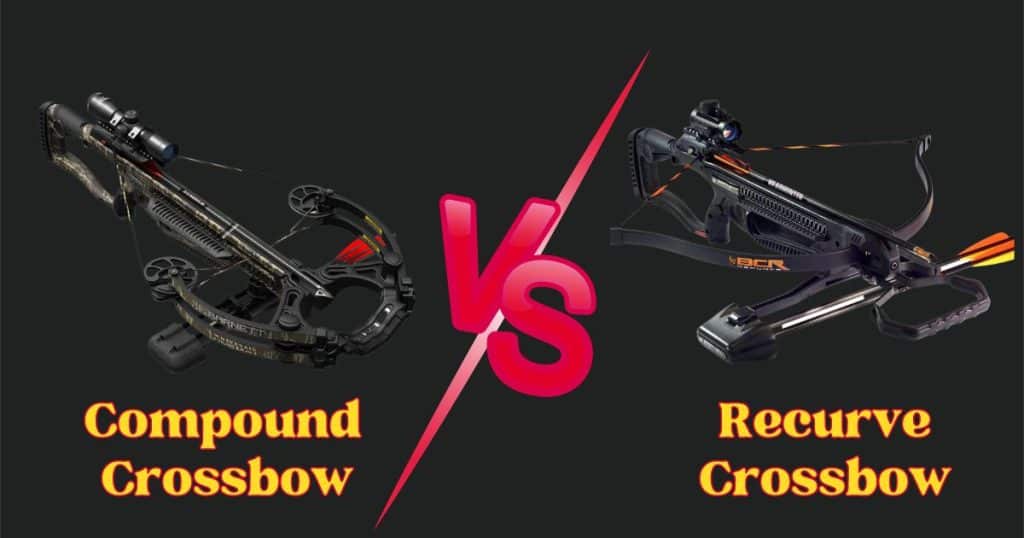Which one is better, recurve or compound crossbow? This is a question you have probably pondered when buying a new crossbow. You are not alone, and honestly, there is no definitive answer as to which is better, as they both have pros and cons.
Analyzing what they both offer will help you decide what kind of crossbow to purchase. So, let’s look at the two and how they differ.

The Recurve Crossbow
The recurve crossbow is the more common of the two and is what most people think of when thinking of crossbows. These crossbows are simpler and easier to use. These crossbows get their name from the fact that the tips of the limbs curve away from the shooter.
The curved tips act as a lock and strain mechanism, preventing the string from flocking when fired. Because of their minimal design, these crossbows tend to be more manual to operate and have larger limbs, as well as the barrel. Furthermore, they are usually larger but lightweight.
The Compound Crossbow
Compound crossbows are a modern take on the traditional recurve crossbow. Instead of manual operation, these crossbows have cams and cables that take up some of the load when pulling the string. Because of this, they tend to be heavier with shorter limbs.
Also, compound crossbows are usually more powerful and can fire projectiles at higher velocities.
The Evolution of Crossbow Technology
Crossbow enthusiasts have long appreciated the advantages of recurve crossbows, particularly models like Excalibur. Recurve crossbows are celebrated for their reliability, field-serviceability, and ease of maintenance. These qualities have made them a staple for hunters who value self-sufficiency in the field. The ability to change the string on the go, without requiring an intricate setup or timing adjustments, is a significant plus for recurve crossbow devotees.
However, as the crossbow industry evolves, we see a diminishing gap between compound and recurve crossbows. Manufacturers like Mission Crossbows have incorporated innovative features, including built-in bow presses, which enable string and cable changes in compound crossbows. This development has gradually eroded one of the longstanding advantages of recurve crossbows.
A Quick Comparison: Recurve Crossbow vs Compound Crossbow
| Aspect | Recurve Crossbow | Compound Crossbow |
|---|---|---|
| Operation | Manual operation; requires more effort to fire | Utilizes cams and cables for easier cocking and firing |
| Kinetic Energy Generation | Relies on physical effort for kinetic energy generation | Generates more kinetic energy with less physical effort |
| Draw Weight | Draw weight increases as the string is pulled | Most weight is felt at the start of the draw and decreases |
| Design Consideration | Simpler design with fewer moving parts | Complex design with cams and cables |
| Accuracy and Precision | Highly accurate; may have slightly more recoil | Highly accurate with reduced recoil |
| User Experience | Can vary; simpler design may be easier for some | Compact design; may offer better ergonomics |
| Power | Less powerful due to manual operation | More powerful due to mechanical advantage |
| Durability | Simplicity can make them more durable | More moving parts may lead to potential wear and tear |
| Size | Larger and longer | Smaller and more compact |
| Noise | Quieter when fired; better for stealth in hunting | May produce more noise and vibration |
| Cost | Generally more affordable | Typically pricier due to additional mechanisms |
Differences Between Recurve and Compound Crossbows: A detailed Discussion
There are many differences between the recurve and compound crossbows. The main is in how they operate. The recurve crossbow is more traditional and requires considerable effort from the shooter to fire. The compound crossbows, on the other hand, use a series of cams and cables to cock and fire arrows.
Kinetic Energy Generation
Kinetic energy is the energy an object has while in motion. Thus, from this definition, it is clear that kinetic energy in crossbows is generated in the same way. That is when you pull the string of the bow towards you and get the tips of the bow closer together.
This releases the bow and generates kinetic energy. When it comes to the two crossbows, while the process of generating kinetic energy is similar, the amount differs. Compound crossbows can create more kinetic energy, as using cams and cables allows you to do more with minimal physical effort.
On the other hand, in a recurve crossbow, the kinetic energy of the arrows will be based on the amount of physical effort you exert on the bow when pulling the string.
Draw Weight
Draw weight is the force needed to pull back a bowstring to full draw. In a recurve bow, the draw weight increases as you pull back the string. As such, more physical effort is needed to bring it to full draw.
In a compound crossbow, however, the weight is distributed to the limbs and cables. With a compound crossbow, most of the weight is felt at the start of the draw and decreases as it reaches the full draw. Thus, compound crossbows can have higher draw weights.
Uncocking the Crossbow
In the early days of crossbow hunting, recurve crossbows had a notable edge in terms of uncocking. The simplicity of being able to uncock a recurve crossbow made it a preferred choice for hunters who wanted to avoid the hassle of carrying specialized arrows or targets into the field. This feature allowed for safe and straightforward uncocking after a hunt.
However, compound crossbows have caught up in this regard. Most modern compound crossbows even at priced less than $200 now offer convenient and easy uncocking options, rendering the uncocking advantage of recurve crossbows virtually obsolete.
Cocking Mechanisms: Rope vs. Crank
One area where compound crossbows are gaining an upper hand is in cocking mechanisms. While some high-speed compound crossbows require external devices, like crank systems, to achieve their remarkable speeds, many mid-range compound crossbows can still be cocked with rope cocking devices. This feature enhances accessibility and makes the cocking process more user-friendly.
On the other hand, recurve crossbows often require higher draw weights, such as 285 pounds, to achieve modern speeds. This can make them less user-friendly for some individuals who prefer lower draw weights and the convenience of rope cocking devices.
If you’re interested in learning how to cock a crossbow like a pro with avoiding common mistakes, check out our detailed guide on How to Cock a Crossbow for step-by-step instructions and tips.
Design Consideration
As mentioned earlier, recurve crossbows have a simpler design comprising a single string and the limbs. This makes them easier to use and maintain as no complex mechanisms exist. And in certain hunting situations, it makes them better.
Compound crossbows, on the other hand, have a more complex design with a series of cams and cables. This makes them harder to maintain and use as more moving parts are needed. This is something to consider when choosing between the two.
The complex design of the compound crossbow makes it more powerful and accurate than the simpler recurve crossbow.
Accuracy and Precision
Both recurve and compound crossbows can be highly accurate in the hands of a skilled shooter. However, compound crossbows often have the edge due to their consistent power and reduced recoil. Factors such as the design of the crossbow, the quality of the optics, and the shooter’s skill level play significant roles in accuracy.
For those on the quest for the ultimate crossbow tailored for deer hunting, the compound crossbow stands as the prime choice.
User Experience
Ergonomics and comfort are vital aspects of crossbow shooting. The feel of the crossbow in your hands, the ease of aiming, and the comfort of the stock all contribute to your overall shooting experience. This can vary significantly between recurve and compound crossbows.
Power
When it comes to power, compound crossbows are usually more powerful due to their cams and pulley mechanism that do most of the heavy lifting. Recurve crossbows are less powerful than there is more physical effort needed.
Durability
The simplicity of recurve crossbows can make them more durable as fewer things can break. Compound crossbows have more moving parts that are more prone to damage and wear and tear.
Size
Recurve crossbows tend to be larger and longer than compound crossbows. The latter are usually more compact and shorter, though they weigh more than recurve crossbows.
Noise
Stealth is crucial in hunting, and this is where recurve crossbows shine. When fired, they tend to produce less noise and vibration, making them a preferred choice for hunters who prioritize staying undetected in the field.
Speed and Noise Levels
Compound crossbows tend to offer higher speeds with lower draw weights compared to their recurve counterparts. For example, a compound crossbow with a draw weight as low as 140 pounds can still achieve speeds of 400 feet per second or more. This can be especially appealing to hunters who want both power and ease of use.
Additionally, compound crossbows are often praised for their quieter operation. With advancements in technology, some models are incredibly stealthy, generating minimal noise when fired.
Recurve crossbows, although deemed acceptable in terms of noise levels and reduced vibration (attributed to their less complex mechanism), may not quite rival the whisper-quiet performance achieved by certain compound models. In contrast, some contemporary recurve crossbows boast a compact design; however, the trade-off is that their stiffer limbs make them more challenging to cock.
Cost
Since they are more powerful and come with additional mechanisms, compound crossbows tend to be pricier than recurve crossbows.
Pros and Cons of Recurve Crossbows
Recurve Crossbows Pros
- These types of crossbows are easier to maintain due to their simpler design, and you can do it without involving a professional
- They also have fewer moving parts, meaning they are easy to repair in the field when need be.
- They can be more reliable as there are fewer moving parts to contend with
- Due to fewer mechanical dependencies most recent recurve crossbow can propel arrows at a speed of more than 400 FPS.
- Due to their simpler design, they are also lighter than compound crossbows.
- They are also quieter and easier to aim.
Recurve Crossbow Cons
- While they are simple in design, they are often larger than compound crossbows and have wider limbs, making them more challenging to maneuver with.
- Some modern recurve bows feature shorter limbs, which is a great option for use in tight spaces, but due to the shorter and stiffer limbs, they become harder to cock. But in general, if you check out the conventional recurve bows with longer limbs, you’ll find they offer more ease when drawing and better stability, especially for those with longer draw lengths.
- They are not as powerful as compound crossbows and do not produce as much kinetic energy as compound crossbows.
Pros and Cons of Compound Crossbows
Compound Crossbow Pros
- With their cams and cable mechanism, they are more powerful and generate more stopping power than recurve crossbows.
- They are smaller and more compact than recurve bows, making them more maneuverable in the field.
- There is less stress on the trigger sear, which helps prolong the trigger mechanisms’ life.
- They are easier to cock, and less physical effort is needed compared to recurve crossbows.
Compound Crossbow Cons
- Due to the complex cams and cable mechanisms, they are harder to fix in the field and nearly impossible to fix in the field if damaged.
- They are also heavier, which can add up to the overall weight of your hunting gear.
Which To Choose: Recurve Crossbow Or Compound Crossbow
Which of the two crossbow types should you choose as your next hunting weapon? Well, it depends on your hunting style and where you are hunting. If you are hunting in a remote area and weight is a factor, a recurve bow with its reliability will be a great choice.
However, if you are hunting from a blind or an area with thickets, the compact design of the compound crossbow will be better.
Top Recurve and Compound Crossbow Brands
Recurve Crossbow Brands
- Excalibur Bows
- Wicked Ridge
- Barnett
- Centerpoint
Compound Crossbow Brands
- Barnett
- Excalibur Bows
- Tenpoint
- Bear X

About The Author:
Lake Streeter, A Gun enthusiast, and loves to hunt in the middle of the wood. Always check the latest hunting gears out in the market and try to share his honest opinion with the audience in Hunting Nook.

1 thought on “Recurve Crossbow vs Compound Crossbow: Which Packs a Deadlier Punch?”
I have found the recurve crossbow to be a very excellent choice for dove and quail. I also use mine quite a lot for bullfrogs. I used to spend my weekends when I was a kid plinking those big green grasshoppers off the fences and shooting horse flys off the pigs in the lot. With the price off ammo today it makes sense to use a crossbow for just about anything. I have put air tags on all of my bolts so I never loose them.